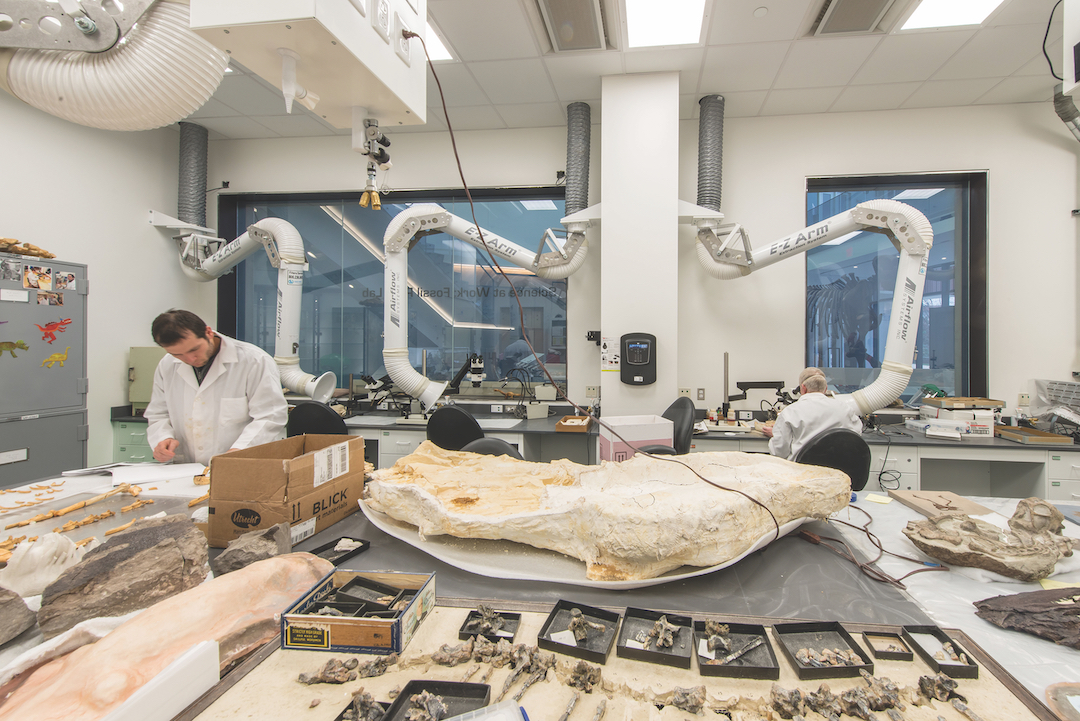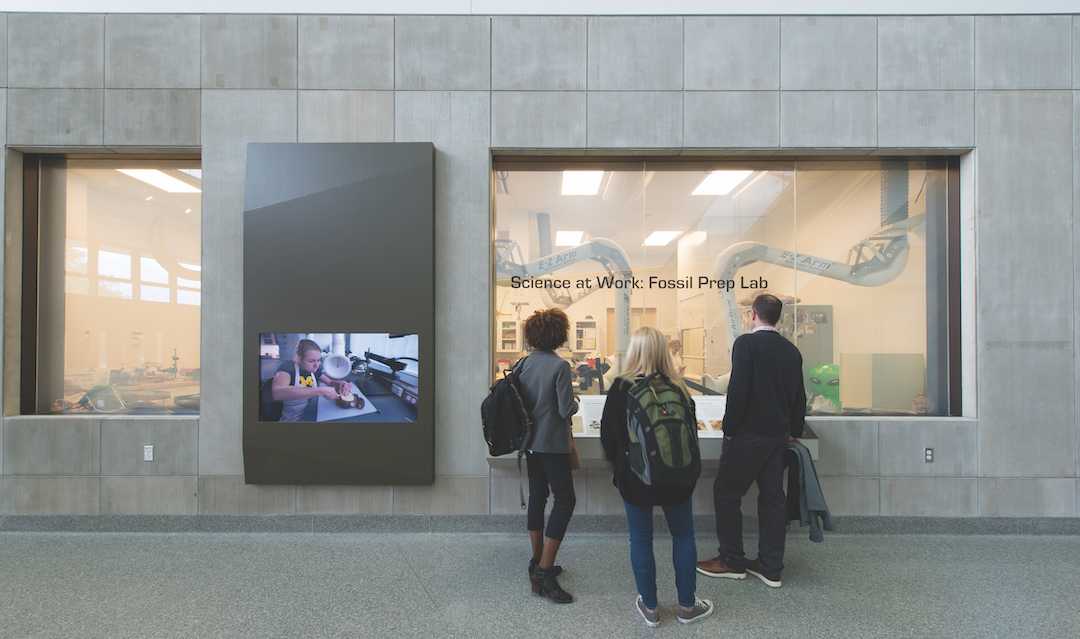The $261 million Biological Sciences Building at the University of Michigan, which opened in April, checks off many of the boxes that science and technology (S+T) sector clients crave.
• It’s a hybrid: this 312,000-sf building includes 84 labs, a plant growth facility, a 60-seat planetarium and domed theater, and is home to the university’s Museum of Natural History.
• It’s multifunctional: The building colocates wet labs with dry spaces for computational science, a major development in this sector.
• It’s aesthetically alert: The building’s exterior cladding is made from 38,500 strips of terra cotta, imported from Germany. The material reconciles the building’s coloration with surrounding buildings on campus.
• It’s transparent: the open-lab concept has three distinct research blocks, each separated by an atrium. Groups of 10 researchers are assigned to one of 11 “neighborhoods.” And the museum winds through the building, taking visitors on a tour that allows them to view visible labs and ask questions of researchers via an intercom system.
“The building itself puts science on display,” says Todd Schliemann, FAIA, Design Partner with Ennead Architects, the project’s design architect. AOR SmithGroup used network analysis software for the first time to guide how the building is organized. “This was a big hit,” says David Johnson, AIA, LEED AP, Vice President and Higher Education Design Strategist, SmithGroup.
SEE ALSO: Top 65 Science and Technology Sector Architecture Firms
SEE ALSO: Top 55 Science and Technology Sector Engineering Firms
SEE ALSO: Top 40 Science and Technology Sector Construction Firms
The S+T sector is arguably the industry’s most complex because it caters to a diverse clientele with specific priorities and imperatives. They include academic research and teaching institutions, healthcare providers, government agencies, and private-sector enterprises like pharma and biotech.
Take, for example, one of Consigli Construction’s recent projects: a 16,000-sf pharmaceutical-grade manufacturing facility that expands the Portland, Maine, headquarters of ImmuCell, an animal medicine provider. This facility, whose construction made extensive use of prefabrication for equipment and building systems (the architect was Stantec), makes a treatment for a common infection found in cows worldwide.
“In the past, it was acceptable to turn over a fully commissioned building and leave it in the hands of the owner to make it fit, functional, and ready for use,” says Eric Danielson, Vice President of Science & Technology and an Innovation Lead with JE Dunn. “Today, there is so much technology needed to operate these buildings, and that doesn’t even take into consideration all of the equipment needed for research and teaching.”
Single-function science and technology (S+T) buildings are passé
That being said, the common thread connecting most S+T clients, say AEC sources, is their need for operational flexibility that doesn’t require major infrastructure or energy-use changes.
One of JE Dunn’s recent projects is the John T. Tate Hall at the University of Minnesota, which opened in March 2018. That 230,000-sf building can accommodate 24 research clusters among the physics, astronomy, and earth sciences schools, with 29 teaching labs and 26 research labs that include a shielded room that diverts the Earth’s magnetic field.
“A new era of team-based research has ushered in the need for flexible spaces with advanced technology to facilitate ongoing collaboration,” says Ryan Molen, a Vice President with McCarthy Building Companies. He adds that design flexibility can also be a factor in recruitment and retention of researchers.
Marilee Lloyd, AIA, National Laboratory Planner with HED, observes that the single-function S+T building “is an anomaly,” and that most of her firm’s clients now want their facilities to “support advancement across multiple business sectors.” Consequently, hybrid buildings are now part of the S+T sector’s mainstream.


The University of Michigan’s Biological Sciences Building houses a Museum of Natural History that wends through the building. Visitors can communicate with researchers through an intercom system. Photos: Aislinn Weidele, Ennead Architects
“The interdisciplinary boundaries have pretty much been obliterated,” says Paul Harney, AIA, NCARB, LEED AP, Principal, Science and Technology with Perkins+Will. “It’s less about the program and more about capability to offer a decent spectrum of different sciences.”
A project that HOK and Vanderweil Engineers worked on is the 628,000-sf Jacobs School of Medicine and Biomedical Sciences building at the University of Buffalo, State University of New York, which opened in December 2017. This building integrates patient care, medical education, and biomedical research. David Schwartz, AIA, LEED AP BD+C, HOK’s Regional S+T Leader, explains that to bring together academic and research, the design places daylit lab spaces on the third, fourth, and fifth floors between the more public parts of the medical education program on the lower floors and the specialized, pedagogical components—including the human anatomy suite and high-tech patient simulation center—on the upper floors.
Open spaces on each level are “learning landscapes,” he says, and classrooms are scalable for lectures or small groups.
Wet and dry laboratory spaces comingle in S+T buildings
To a greater degree than ever, S+T clients are combining wet labs with “dry” labs for computational science. “Data-driven research is becoming more prominent in both institutional and commercial research labs,” says Stephen Lahti, PE, LEED AP BD+C, Project Manager with Vanderweil Engineers. “It will likely continue to grow, as data capacities increase and efficiencies are realized.”
Ted Hyman, FAIA, Managing Partner with ZGF Architects, agrees, noting that “the ability to have data acquisition and theoretical modeling within steps of the wet bench is becoming essential.”
Bringing together disparate room environments is not without its issues. Joshua Yacknowitz, Arup’s Americas Science and Industry Leader, notes that as the lines blur between labs and offices, AEC firms must resolve issues of safety and containment. HED’s Lloyd says multifunctional spaces may have different use patterns, so there are issues around security to contend with, as well as environmental and finish requirements.
S+T space is much in demand. It took Davis Companies, a real estate investment, development, and management firm, only five months to fully lease The Alewife Research Center, a 225,000-sf building that opened last November in Cambridge, Mass. In addition to its five stories of lab space, the building offers 10,000 sf of community space, a tenant lounge, fitness center, bike storage, and an indoor solarium.
Given that S+T companies compete for talent with the tech giants, the buildings they lease must be tenant- and occupant-centric for these companies to attract and keep employees, say AEC firms.
But that’s true of buildings in most typologies these days. There are other trends specific to S+T that AEC firms say they are watching closely.
SEE ALSO: Perkins+Will tests a turnkey laboratory for S+T startups
Brian Hamilton, Consigli’s Director of Healthcare & Life Science, cites cancer immunotherapy moving toward the next generation of therapy products, digital therapeutics to track patients’ routines, regenerative medicine in cell and gene therapies, and personalized medicine that could lead to smaller manufacturing facilities producing targeted treatments.
HED’s Lloyd speaks of “divergent labs” that “look toward the future, embracing potential disruptors, whether it’s outsourcing repetitious experiments, cloud-based research, robotic labs, or an AI algorithm that churns through research data.”
AI is also on the radar of Trevor Wells, Ware Malcomb’s S+T Studio Manager “We will see more algorithm-driven and automated processes. Everything from workstation design and equipment layout to large-scale considerations such as site design and parking will be influenced by the growth of automation and AI.”
Kevin Brettmann, JE Dunn’s Director of S+T, refers to the “Fourth Industrial Revolution,” where space planning is arranged to drive communications and collaboration across a wide range of academic disciplines.
Several AEC sources also talk about the growing demand for smarter buildings. One of P+W’s recent projects—the 149,000-sf Bowie State University Center for Natural Sciences, Mathematics and Nursing—includes 25,000 sf of dynamic glass and sensors that, upon identifying certain contaminants, trigger the HVAC system to increase its air ventilation rate.
MORE FROM BD+C'S 2019 GIANTS 300 REPORT
Related Stories
Construction Costs | May 16, 2024
New download: BD+C's May 2024 Market Intelligence Report
Building Design+Construction's monthly Market Intelligence Report offers a snapshot of the health of the U.S. building construction industry, including the commercial, multifamily, institutional, and industrial building sectors. This report tracks the latest metrics related to construction spending, demand for design services, contractor backlogs, and material price trends.
K-12 Schools | May 15, 2024
A new Alabama high school supports hands-on, collaborative, and diverse learning
In Gulf Shores, a city on Alabama’s Gulf Coast, a new $137 million high school broke ground in late April and is expected to open in the fall of 2026. Designed by DLR Group and Goodwyn Mills Cawood, the 287,000-sf Gulf Shores High School will offer cutting-edge facilities and hands-on learning opportunities.
Adaptive Reuse | May 15, 2024
Modular adaptive reuse of parking structure grants future flexibility
The shift away from excessive parking requirements aligns with a broader movement, encouraging development of more sustainable and affordable housing.
Affordable Housing | May 14, 2024
Brooklyn's colorful new affordable housing project includes retail, public spaces
A new affordable housing development located in the fastest growing section of Brooklyn, N.Y., where over half the population lives below the poverty line, transformed a long vacant lot into a community asset. The Van Sinderen Plaza project consists of a newly constructed pair of seven-story buildings totaling 193,665 sf, including 130 affordable units.
K-12 Schools | May 13, 2024
S.M.A.R.T. campus combines 3 schools on one site
From the start of the design process for Santa Clara Unified School District’s new preK-12 campus, discussions moved beyond brick-and-mortar to focus on envisioning the future of education in Silicon Valley.
University Buildings | May 10, 2024
UNC Chapel Hill’s new medical education building offers seminar rooms and midsize classrooms—and notably, no lecture halls
The University of North Carolina at Chapel Hill has unveiled a new medical education building, Roper Hall. Designed by The S/L/A/M Collaborative (SLAM) and Flad Architects, the UNC School of Medicine’s new building intends to train new generations of physicians through dynamic and active modes of learning.
Sustainability | May 10, 2024
Perkins&Will’s first ESG report discloses operational performance data across key metrics
Perkins&Will recently released its first ESG report that discloses the firm’s operational performance data across key metrics and assesses its strengths and opportunities.
MFPRO+ News | May 10, 2024
HUD strengthens flood protection rules for new and rebuilt residential buildings
The U.S. Department of Housing and Urban Development (HUD) issued more stringent flood protection requirements for new and rebuilt homes that are developed with, or financed with, federal funds. The rule strengthens standards by increasing elevations and flood-proofing requirements of new properties in areas at risk of flooding.
Government Buildings | May 10, 2024
New federal buildings must be all-electric by 2030
A new Biden Administration rule bans the use of fossil fuels in new federal buildings beginning in 2030. The announcement came despite longstanding opposition to the rule by the natural gas industry.
Sustainable Development | May 10, 2024
Nature as the city: Why it’s time for a new framework to guide development
NBBJ leaders Jonathan Ward and Margaret Montgomery explore five inspirational ideas they are actively integrating into projects to ensure more healthy, natural cities.

















